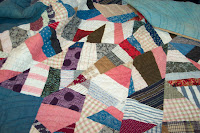Perhaps the things I enjoy best about doing quilt restoration and repair is the sense of hands reaching across time. There is definitely a hands on appreciation and caring that goes into the work, as I evaluate the piece in front of me and try to imagine how the maker or makers must have felt about it.
The block to the left is definitely one that I have pondered over and tried to find an answer to since I first found it in he 1980s. Most blocks of this type would be around $200 just for one block; this one, found in a basket of orphan blocks, was passed over many times though its price was just $2. I grabbed it up even though it had very obvious slashes in it.
When I got it home, I examined it carefully, and reached the definite conclusion that the slashes - 7 of them in all, were intentional, definitely not an accident. I have a degree in Archaeology and one of the things we learn during our practice is how to look at things and determine whether they occur naturally or accidentally, or whether they occur by intention.
My mind began to think about all the possible reasons for the slashing. Could it have been a sign of mourning for this person who was more than likely deceased? Or is it possible that it was something perhaps done in anger for some act this person had committed. At any rate, here it was, and since my goal is to make things whole and beautiful once again, I set out to mend it. If you click on the photo, you can see how I hve carefully mended the slashes, all of them. Then I added some batting and backing of unbleached muslin, which is always appropriate, and I am quilting it and shall frame it when done so that it can be preserved and appreciated.
 I teach classes in this art too, and the classes are always well received. I think once people realize that it is not something that only a person who does this professionally can do, but something that really anyone can learn to do with some degree of knowledge about what is appropriate and best suited for the piece to be restored or repaired. The physical skills of stitching correctly are within the reach of those who really are motivated and encouraged to repair or restore their family heirloom.
I teach classes in this art too, and the classes are always well received. I think once people realize that it is not something that only a person who does this professionally can do, but something that really anyone can learn to do with some degree of knowledge about what is appropriate and best suited for the piece to be restored or repaired. The physical skills of stitching correctly are within the reach of those who really are motivated and encouraged to repair or restore their family heirloom.  Yes, they do need to know what fabrics are appropriate to use, and what methods are best suited, and what tools can help them to do a good job, but I have had students who did all of those things. It just isn't something everyone wants to attempt any more than some folks who quilt would never dream of creating an art quilt even though they might do beautiful traditional work.
Yes, they do need to know what fabrics are appropriate to use, and what methods are best suited, and what tools can help them to do a good job, but I have had students who did all of those things. It just isn't something everyone wants to attempt any more than some folks who quilt would never dream of creating an art quilt even though they might do beautiful traditional work.It is not cheap to have a quilt repaired or restored, depending on what needs to be done. And in these times, you might be thinking about putting it off. That is very understandable. Some of us will work on a payment basis to try to help our clients. It isn't the kind of investment that will pay you dividends, but it IS an investment to keep your family history intact.
And remember too that you CAN learn to do the work yourself, and in a short time. If you do take the class and need help along the way, I am always there to assist my students.
Whichever way you choose to deal with your quilt needing restoration or repair, I look forward to working with you.




No comments:
Post a Comment